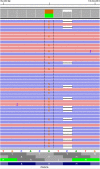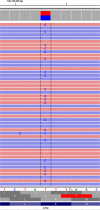Next-Generation Sequencing in Salivary Gland Basal Cell Adenocarcinoma and Basal Cell Adenoma
- PMID: 27224988
- PMCID: PMC5082054
- DOI: 10.1007/s12105-016-0730-9
Next-Generation Sequencing in Salivary Gland Basal Cell Adenocarcinoma and Basal Cell Adenoma
Abstract
Basal cell adenoma and basal cell adenocarcinoma represent basaloid salivary gland neoplasms that show cyto-morphologic similarity but differ at the histologic level by their invasive qualities, as adenocarcinomas show invasion beyond their capsule, a finding not seen in the adenomas. Due to the low incidence of these tumors, the molecular mechanism underlying their pathogenesis is poorly understood. We sought to further delineate these neoplasms through mutation profiling by targeted next-generation sequencing (NGS). Twenty cases (basal cell adenocarcinoma = 10; basal cell adenoma = 10) were retrospectively selected from a previous analysis. NGS was performed using the Ion AmpliSeq™ Cancer Hotspot Panel v2 (Life Technologies, Carlsbad, CA). The data was analyzed using the Ion Torrent Suite Software (Life Technologies) followed by a laboratory-developed pipeline. One of eight cases of basal cell adenocarcinoma had a mutation, which was an activating mutation in PIK3CA (c.3140A>G, p.H1047R). No mutations were detected in the remaining basal cell adenocarcinomas. In the basal cell adenomas, the CTNNB1 p.I35T mutation was identified in three of nine (3/9) cases. A missense mutation in the ATM gene (c.2572T>C, p.F858L) was seen in a basal cell adenoma with an allele frequency of 53 %, raising the possibility of a germline mutation. The overall findings suggest that although there is cytomorphologic similarity, differences exist between these two tumors at the histologic and genetic level. Although the numbers of cases are limited, the aberrations in genes affecting different signaling pathways in the basal cell adenocarcinoma versus the basal cell adenomas suggest that basal cell adenocarcinoma likely arises de novo and not from basal cell adenoma.
Keywords: Basal cell adenocarcinoma; Basal cell adenoma; Next generation sequencing (NGS); Salivary gland neoplasms.
Conflict of interest statement
The authors have no conflicts of interest to report.
Figures






Similar articles
-
Distinctive Patterns of CTNNB1 (β-Catenin) Alterations in Salivary Gland Basal Cell Adenoma and Basal Cell Adenocarcinoma.Am J Surg Pathol. 2016 Aug;40(8):1143-50. doi: 10.1097/PAS.0000000000000669. Am J Surg Pathol. 2016. PMID: 27259009
-
Difference in transducin-like enhancer of split 1 protein expression between basal cell adenomas and basal cell adenocarcinomas - an immunohistochemical study.Diagn Pathol. 2018 Jul 27;13(1):48. doi: 10.1186/s13000-018-0726-8. Diagn Pathol. 2018. PMID: 30053869 Free PMC article.
-
Nuclear β-catenin expression in basal cell adenomas of salivary gland.J Oral Pathol Med. 2011 Jul;40(6):460-6. doi: 10.1111/j.1600-0714.2011.01010.x. Epub 2011 Feb 16. J Oral Pathol Med. 2011. PMID: 21323741
-
Infarction of basal cell adenoma of the parotid gland: First case report and literature review on CTNNB1 I35T mutations in salivary basal cell neoplasms.Oral Oncol. 2023 Oct;145:106534. doi: 10.1016/j.oraloncology.2023.106534. Epub 2023 Jul 28. Oral Oncol. 2023. PMID: 37517215 Review.
-
Molecular Genetic Features of Primary Nonurachal Enteric-type Adenocarcinoma, Urachal Adenocarcinoma, Mucinous Adenocarcinoma, and Intestinal Metaplasia/Adenoma: Review of the Literature and Next-generation Sequencing Study.Adv Anat Pathol. 2020 Sep;27(5):303-310. doi: 10.1097/PAP.0000000000000268. Adv Anat Pathol. 2020. PMID: 32520749 Review.
Cited by
-
Wnt/β-catenin activation by mutually exclusive FBXW11 and CTNNB1 hotspot mutations drives salivary basal cell adenoma.Nat Commun. 2025 May 19;16(1):4657. doi: 10.1038/s41467-025-59871-3. Nat Commun. 2025. PMID: 40389436 Free PMC article.
-
Role of Histone Deacetylases in the Pathogenesis of Salivary Gland Tumors and Therapeutic Targeting Options.Int J Mol Sci. 2023 Jun 12;24(12):10038. doi: 10.3390/ijms241210038. Int J Mol Sci. 2023. PMID: 37373187 Free PMC article. Review.
-
S100-positive stroma in salivary gland basal cell adenomas: a neoplastic component with CTNNB1 mutations.Virchows Arch. 2025 May;486(5):1033-1038. doi: 10.1007/s00428-024-04021-1. Epub 2024 Dec 26. Virchows Arch. 2025. PMID: 39724428
-
Proceedings of the 2024 North American Society of Head and Neck Pathology Companion Meeting, Baltimore, MD, March 24, 2024: Navigating Ancillary Studies in Basaloid/Blue Salivary Tumors.Head Neck Pathol. 2024 Mar 25;18(1):24. doi: 10.1007/s12105-024-01626-5. Head Neck Pathol. 2024. PMID: 38526755 Free PMC article. Review.
-
A Subset of Salivary Intercalated Duct Lesions Harbors Recurrent CTNNB1 and HRAS Mutations: A Molecular Link to Basal Cell Adenoma and Epithelial-Myoepithelial Carcinoma?Head Neck Pathol. 2023 Jun;17(2):393-400. doi: 10.1007/s12105-022-01513-x. Epub 2022 Dec 8. Head Neck Pathol. 2023. PMID: 36480093 Free PMC article.
References
-
- de Araujo VC, et al. Basal cell adenoma. In: Barnes EL, Eveson JW, Reichart P, et al., editors. World Health Organization Classification of tumors: pathology and genetics of head and neck tumours. Lyon: IARC Press; 2005. p. 261.
-
- Ellis GL, Auclair PL. Tumors of the salivary glands. Atlas of tumor pathology. 4th series, fascicle 9. Silver Spring, MD: ARP Press; 2008. p. 71–85; 269–281.
MeSH terms
Substances
Grants and funding
LinkOut - more resources
Full Text Sources
Other Literature Sources
Medical
Research Materials
Miscellaneous

